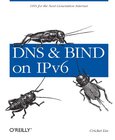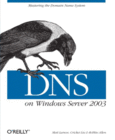Cricket Liu eBooks
Download free Cricket Liu eBooks
DNS and BIND on IPv6
If you're preparing to roll out Ipv6 on your network, this concise book provides the essentials you need to support this protocol with Dns. You'll learn how Dns was extended to accommodate Ipv6 addresses, and how you can configure a Bind name server to run on the network. This book also features methods for troubleshooting problems with Ipv6 forward- and reverse-mapping, and techniques for helping islands of Ipv6 clients communicate with Ipv4 resources. Topics include: Dns and Ipv6 Learn the structure and representation of Ipv6 addresses, and the syntaxes of Aaaa and Ptr records in the ip6.arpa Ipv6 reverse-mapping zone Bind on Ipv6 Use Ipv6 addresses and networks in Acls, and register and delegate to Ipv6-speaking name servers Resolver Configuration...
DNS on Windows Server 2003
3rd Edition
While computers and other devices identify each other on networks or the Internet by using unique addresses made up of numbers, humans rely on the Domain Name System (DNS), the distributed database that allows us to identify machines by name. DNS does the work of translating domain names into numerical IP addresses, routing mail to its proper destination, and many other services, so that users require little or no knowledge of the system. If you're a network or system administrator, however, configuring, implementing, and maintaining DNS zones can be a formidable challenge. And now, with Windows Server 2003, an understanding of the workings of DNS is e...
DNS & BIND Cookbook
The DNS BIND Cookbook presents solutions to the many problems faced by network administrators responsible for a name server. Following O'Reilly's popular problem-and-solution cookbook format, this title is an indispensable companion to DNS BIND, 4th Edition, the definitive guide to the critical task of name server administration. The cookbook contains dozens of code recipes showing solutions to everyday problems, ranging from simple questions, like, "How do I get BIND?" to more advanced topics like providing name service for IPv6 addresses. It's full of BIND configuration files that you can adapt to your sites requirements.With the wide range of recipes in this book, you'll be able toCheck whether a name is registered Register your domain...
2007 - 2017 © eBooks-IT.org



